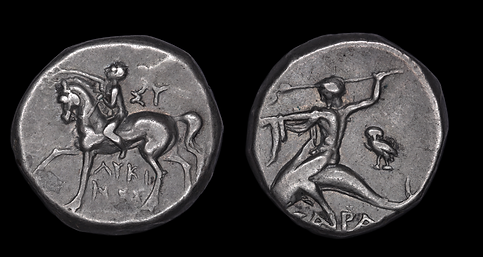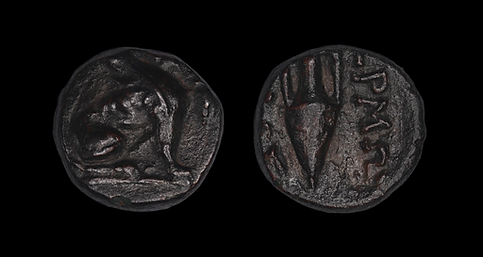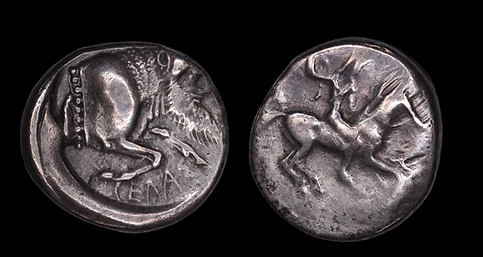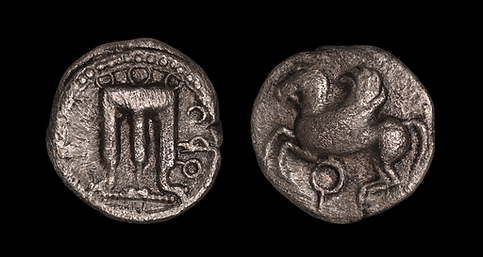
Diomedes Ancient Coins
These are coins which have been acquired mainly for research purposes or because of their scarcity.

Achaian League. Antigoneia (Mantineia). Circa 188-180 BC. Triobol or Hemidrachm (Silver, 14.5 mm, 2.32 g, 2 h). Obv: Laureate head of Zeus to right. Rev: Achaian League monogram between A and N, with a monogram below; all within laurel wreath.

Aeolis, Kyme, AE12. 1.16 g. Magistrate Heraios. 250-190 BC. Obv: Head of the Amazon Kyme right. Rev: K-Y HΡAIOΣ to left, right and beneath one-handled cup.

Argolis, Argos. Triobol, 320-270, 13.6mm 2.66g. Obv: Forepart of wolf left. Rev: A within incuse square, A-Ρ across upper fields, club below.

Attica, Athens AR Drachm. Circa 454-404 BC. Obv: Helmeted head of Athena right. Rev: Owl standing right, head facing; olive sprig and crescent behind; AQE in right field; all within incuse square. Condition: Very Fine. Weight: 3.9g Diameter: 15 mm

Bruttium, Caulonia Drachm circa 500-480, AR 15.00 mm., 1.89 g. Obv: Apollo advancing right, holding branch; small daimon running right on Apollo's left arm; to right, stag standing right, head reverted. Rev: Incuse of obverse, but no branch, daimon, or ethnic.

Bruttium, Kaulonia, c. 475-425 BC. AR Stater (20mm, 8.06g, 5h). Obv: Nude Apollo walking right, holding branch, holding small running daimon on outstretched arm; before, stag standing right, head turned back. Rev: Stag standing right. Die-break.

Bruttium, Kroton. Ca. 480-430 BC. AR stater (21mm, 11h). Obv: ϙPO (retrograde), tripod with leonine feet; heron standing left in right field, dotted border on thick raised band. Rev: Incuse tripod, linear outline within tripod; all within striated border on incuse rim.

Bruttium, Laus. AR Triobol, c. 500-480 BC. Obv: Man-headed bull to left, head turned backwards; ΛAΣ above. Rev. Man-headed bull to right; ΛAΣ (retrograde) above. 1.33 g. 10.00 mm.

Bruttium, Rhegion Æ Obol. Circa 260-218 BC. Obv: Head of Artemis right, bow and quiver over shoulder. Rev: PHΓI-NΩN, lyre. 5.49g, 21 mm

Calabria, Tarentum AR Drachm. Circa 281-276 BC. Zor..., magistrate. Obv: Head of Athena to right, wearing crested Attic helmet adorned with Skylla preparing to hurl a stone, Rev: Owl standing to right on olive branch, head facing; ZOR to right, TAP to left. 3.07g. / 16mm

Calabria, Taras, ca 272-240 BC. AR Nomos (19.5mm, 6.38 g, 9h) Reduced standard. Obv: Youth on horseback left, crowning horse and holding rein; ΣY to right, ΛYKI/NOΣ below. Rev: Phalanthos, preparing to throw trident left, on dolphin left; to right, owl standing left, head facing.

Campania, Neapolis. Circa 300-275 BC. Didrachm or Nomos (Silver, 20 mm, 7.14 g, 3 h), Chari..., magistrate. Obv: Diademed head of a nymph to right, wearing pendant earring and necklace; below, XA; behind, kantharos. Rev: [ΝΕΟ]ΠΟΛΙΤΩ[Ν] Man-headed bull walking to right, head facing; above, Nike flying right to crown the bull.

Epirus, Ambrakia . Circa 404-360 BC. AR Stater. Pegasos flying right; A below / Helmeted head of Athena left; bunch of grapes and kylix behind.

Islands off Ionia, Chios circa 431-412 BC. Bronze Æ. 10 mm, 0.97 g. Obv. Sphinx seated right, grapes to right. Rev. Amphora, magistrate name [E] ΡΜΩ [N]

Ionia, Ephesos. AE 18, 4.57g, ca. 350 BC. Obv: Bee. Rev: Stag standing right, date palm behind, ΩΣ monogram to right.

Ionia, Miletos. AE 19mm. 2nd Century BC. Obv: Laureate head of Apollo right. Rev: Lion standing right, head turned back; star above

Ionia, Teos. Hemidrachm. 400-300 BC. Obv: Griffin. Rev.: Kantharos. 1,53 g.

Caria, Rhodes, ca 350-300 BC. AE 10mm. Obv: Diademed head of Rhodos right, in earring and necklace. Rev: rose

Lucania, Herakleia circa 432-330 BC. Diobol AR 13 mm, 1.01 g. Obv: Helmeted head of Athena right. Rev: Herakles standing facing, half-turned to right, wrestling the Nemean lion.

Lucania, Metapontum. Diobol circa 440-340, AR 10.00 mm., 0.63 g. Obv: Ear of barley. Rev: Head of river-god Acheloos

Lucania, Metapontum. AE Obol, c. 400-350 BC. Obv: Head of Nike right; O behind; below, [NIKA]. Rev: [M]-E. Ear of barley with six grains; ithyphallic herm to left. AE. 5.97 g. 21.00 mm.

Lucania, Metapontion. 280-270 BC, Diobol, 1.02g. Obv: Helmeted head of Athena right. Rev: Wheat ear, META to left, leaf and cornucopia to right.

Lucania, Metapontum, AR diobol, 325-275 BC. Obv: helmeted of Athena to right. Rev: Barley ear with leaf. On the left, MET. To the right, cornucopia. 1.02 g.

Lucania, Sybaris, c. 453-448 BC. AR Triobol (8mm, 1.05g, 11h). Obv: Poseidon advancing right, wielding trident. Rev: Bird standing r. within circular incuse.

Lucania, Sybaris. AR Obol, circa 530-510 BC. Obv: Bull standing to left, head to right. Rev: Large M V

Lucania, Sybaris, c. 510-475 BC. AR Triobol (11mm, 1.00g). Obv: Bull standing right, head left. Rev: Incuse acorn.

Lucania, Velia. AR Nomos, circa 334-300 BC. Obv: Helmeted head of Athena left; monogram behind neck guard. Rev: Lion standing left, devouring prey; Φ between legs; YEΛHTΩN in exergue

Lycia, Aruwatijesi. Circa 400-370 BC. AR Drachm (3 Gr. 16mm.). Obv: Lion scalp facing. Rev: Triskeles.

Lydia, Sardes, AE21, civic issue, 7.82 g. Obv: Draped bust of Artemis right, bow and quiver behind shoulder. Rev: ΣAΡΔIANΩN, Athena standing left, holding Nike and spear, shield at her side.

Macedonia, Emathian District, Lete c. 530-480 BC. 1/8 stater, 1.27g. Obv: Satyr squatting right, to right and left pellet. Rev: Incuse square, rough

Macedonia, Philipp II of Macedonia AE15, 8.40g, 15.80 mm. 359-336 BC. Obv: Head of Apollo right, wearing taenia. Rev: Naked youth on horse prancing right, Π below

Charles A. Lindbergh Medal of Congress; Obverse: profile bust of Lindbergh wearing a leather flight helmet, embossed letter text "LINDBERGH MEDAL OF THE CONGRESS UNITED STATES OF AMERICA"; Reverse: a relief of a lone eagle in flight through day and night depicted.

Mysia, Kyzikos. AR Trihemiobol. 1.03 g. After 480 BC. Obv: Forepart of running boar left, tunny fish swimming upwards behind. Rev: Head of roaring lion left, within shallow incuse square.

Mysia, Pergamon. 133-67 BC. Cistophoric Tetradrachm. Obv: Serpent emerging from cista mystica; all within ivy wreath. Rev: Bow-case with two serpents; monogram within wreath and AP above, monogram in left field, serpent-entwined thyrsus right.

Pamphylia, Aspendos, AR Stater. ca. 465-430 BC. 18.5 mm, 10.80 g. Obv: Naked warrior walking right, holding sword, shield on left arm. Rev: Triskeles of human legs in incuse square.

Constantine I the Great AD 306-337. Antioch. Follis Æ. 16 mm, 1,60 g

Constantine I the Great, 307-337 AD. Bronze follis, struck 324-325 AD. Obv: His laureate head right, CONSTANTINVS AVG Rev: Roman castle camp-gate with two turrets, star above, PROVIDENTIAE AVGG; Mintmark below.

Sicily, Gela. AR Didrachm (8.44g). c. 485-475 BC. Obv: Horseman riding right, preparing to cast javelin. Rev: ΓΕΛΑΣ, forepart of man-headed bull right within incuse circle.

Sicily, Morgantina. AE 16 mm, c. 340 BC. Obv: Head of Apollo right, laureate. Rev: Tripod. 3.44 g. 16.00 mm.

Sicily, Syracuse, under Hiketas. AE 25, 288-279 BC, 25.0mm 8.64g. Obv. ΔIOΣ EΛΛANIOY Laureate head of young Zeus Hellanios right. Rev. ΣYΡAK-OΣIΩN, Eagle standing left on thunderbolt

Sicily, Syracuse. Time of Hieron II. Obv: Laureate head to left; wheel(?) behind. Rev: Warrior, holding couched lance, on horse prancing to right

Sikyona, Sikyon. Hemidrachm, 330-300 BC, 16.0mm 2.77g. Obv. Chimera passing left. Rev. Dove flying left

Thessaly, Kierion. Circa 350 BC. Trihemiobol (Silver, 15 mm, 1.19 g, 12 h). Obv: Head of the nymph Arne to right. Rev: KIEPIEIΩΝ The nymph Arne kneeling right, head to left, playing with astragaloi.

Thessaly, Perrhaebi. 300-200 BC. AE Trichalkon (19.5mm, 7.38g). Obv: Laureate head of Zeus right. Rev:ΠΕΡΡΑΙΒΩΝ, Hera, wearing chiton and veil, seated right on stool, holding sceptre, ΣΩ to inner right.

Thrace, Byzantion. Ae (3rd century BC). Alliance issue with Kalchedon. Obv: Veiled head of Demeter right, wearing grain wreath. Rev: BYZAN / KAΛXA. Poseidon seated right on rocks, holding aphlaston and trident; ΔA to inner right. Weight: 10.57 g. Diameter: 27 mm.

Thrace, Thasos, 510-490 BC. AR Stater. Obv: Naked ithyphallic satyr carrying off a nymph who raises her arm in protest. Rev: Quadrapartite incuse square.

Troas, Gergis. Ae (4th century BC). Obv: Laureate head of Sibyl Herophile facing slightly right. Rev: ΓΕΡ. Sphinx seated right. Weight: 0.73 g. Diameter: 90 mm.

Achaia, Achaean League, Antigoneia (Mantineia) Silver Hemidrachm c188-180 BC. Obv: Laureate head of Zeus right. Rev: Achaian League monogram; A-N across field, monogram below; all within wreath

Aiolis, Kyme circa 350-250 BC. Obv: Eagle standing right. Rev: K-Y to left and right of cup with one handle, one pellet below

Attica, Athens. Obol (Circa 515-510 BC). "Wappenmünzen" type. Obv: Wheel with four spokes. Rev: Quadripartite incuse square, divided diagonally. Weight: 0.53 g. Diameter: 8 mm.

Bruttium, The Brettii. AE 18 mm 4.60 g., c. 214-211 BC. Obv: Diademed bust of Nike left. Rev: Zeus striding right, brandishing thunderbolt and holding sceptre; to right, cornucopia.

Bruttium, Kaulonia circa 475-425 BC. 1/3 Stater AR. Obv. Apollo advancing right brandishing laurel branch. Rev. Stag standing right.

Bruttium, Kroton, AR Diobol c.280-250 BC. Obv: Head of Athena in Corinthian helmet right. ϘΡΟT above. Rev: Herakles standing right leaning on club.

Bruttium, Kroton. 525-425 BC. Obv. Delphic tripod. Right, ϘPO (retrograde). Rev. Pegasus in flight left, Ϙ below.

Bruttium, Locri Epizephiroi. AE 23 mm. period of Pyrrhus, c. 280-275 BC. Obv: Head of Athena left, wearing plain Corinthian helmet, without neck-guard; behind, barley ear. Rev: Pegasos flying left; below, monogram and ΛOKPΩN. 10.87 g. 23.00 mm.

Bruttium, Terina, c. 300 BC. AR Drachm (15mm, 2.33g, 12h). Obv: Female head left, wearing triple-pendant earring; [triskeles] behind. Rev: Nike seated left on cippus, holding bird in extended right hand; monogram to left

Calabria, Taras. Obol, 280-228 BC, 9.0mm 0.63g. Obv: Shell. Rev: Dolphin above a thunderbolt.

Campania, Neapolis. AR Didrachm, c. 300 BC. Obv: Head of nymph right, surrounded by dolphins. Rev: Man-headed bull right; above, Nike flying right, placing wreath on bull.

Caria, Halicarnassus. C. 510-480 BC. AR hecte (12mm). Obv: Head of ketos right, with pointed ear, pinnate mane, long snout, and mouth open with protruding tongue. Rev: Design with four lattice concave sides, segmented border, and central starburst; all in square incuse. .

Euboea, Histiaia. AR tetrobol. 196-146 BC; 14.0 mm, 1.75 g. Obv: Head of nymph Histiaia right, wreathed with vine. Rev: Nymph Histiaia seated right on stern of galley, holding naval standard

Ionia, Ephesos, AR drachm, 500-420 BC. Obv: Bee surrounded by EΦ-EΣI-O-N. Rev: Four-part hollow square. 3.29 g.

Alexander III AR Drachm. c310-301 BC. Kolophon mint. Obv: Head of Herakles right, wearing lionskin headdress. Rev: AΛEΞANΔΡOY, Zeus seated left, holding eagle and sceptre, K to left, crescent beneath chair.

Ionia, Miletos. AR 1/12 Stater. c 525 BC. Obv: Lion's head right. Rev: Star ornament within incuse square

Cycladic Islands, Delos. Bronze, 280-166 BC, 9.7mm 0.84g Obv: Laureate head of Apollo. Rev: Kithara, Δ-Η separated left and right.

Islands off Troas, Tenedos. Early-mid 5th century BC. AR Hemidrachm (14mm, 1.77 g, 8h). Obv: Archaic janiform head, male on left, female on right (Zeus and Hera?). Rev: Labrys within pelleted border within incuse square.

Lucania, Metapontum. Triobol circa 470-440, AR 12.00 mm., 0.97 g. Obv: Barley ear. Rev: Incuse bucranium.

Lucania, Metapontion Æ 15mm. Circa 250-207 BC. Obv: Athena Promachos advancing to left, brandishing spear and shield. Rev: Owl standing on grain ear to right, head facing; META upwards to left. 3.12g, 15mm, 12h.

Lucania, Metapontion. AR Nomos. Circa 340-330 BC. Obv: Head of Demeter left, wearing wreath of grain ears, single-pendant earring, and pearl necklace. Rev: Barley ear with leaf to right; to left, kerykeion above ΛY; ME-TA upward to right. 6.69 gm, 20 mm.

Lucania, Metapontion, c. 300-250 BC. Æ (15.5 mm, 2.7 g). Obv: Head of Demeter left, wearing barley-wreath and pendant earring. Rev: META, barley-ear with leaf to right, above, flower (?).

Lucania, Posidonia. AR Diobol, c. 410-350 BC. Obv: Poseidon advancing right, wearing chlamys and wielding trident; before, traces of ethnic; behind, II (mark of value). Dotted border between double linear border. Rev: Bull walking left; above, two annulets (mark of value).1.07 g. 9.00 m

Lucania, Sybaris. AR Triobol, c. 446-440 BC. Obv. Head of Athena right, wearing wreathed Attic helmet. Rev. Bull right, head turned back; in exergue, ΣΥΒΑ. ΑR. 1.16 g. 13.00 mm.

Lucania, Sybaris. AR Drachm, c. 550-510 BC. Obv. Bull standing left, head right; VM in exergue. Rev. Incuse of obverse, but no ethnic. 2.51 g. 18.00 mm.

Lucania, Sybaris. Drachm from ca. 550-510 BC. Obv: Bull standing left, head turned back. In exergue VM.
Rev: same type, incuse.

Lycia, Kherẽi ? (Circa 430-410 BC). Obol. Obv: Helmeted head of Athena right. Rev: Head of Kherẽi right, wearing kyrbasia; all within pelleted circle within incuse circle. Weight: 0.62 g. Diameter: 9 mm.

Lydia, Sardes. Xerxes. Siglos. Carradice type IIIa style, light standard, without pellets. Obv. Persian king with beard and crown, wearing kidaris and kandys, quiver over shoulder, in kneeling-running stance right, holding transverse spear in right hand and bow in left. Rev: Oblong incuse punch

Macedonia, Philip II (359-336 BC). Tetradrachm. Amphipolis. Obv: Laureate head of Zeus right. Rev: ΦΙΛΙΠΠΟΥ. Youth, holding palm frond, riding horse right. Controls: monogram below horse, Λ below raised foreleg. Weight: 13.34 g. Diameter: 24 mm

Macedonia, Amyntas III. 394/3-370/69 BC. AR Stater (20mm, 8.87 g, 12h). Aigai or Pella mint. Obv: Head of Herakles right, wearing lion skin. Rev: Horse standing right within linear border within incuse square.


Obv: TRAVERSEE EST-OUEST DE L’ATLANTIQUE NORD PAR COSTES ET BELLONTE. Bustes accolés à gauche de Costes et Bellonte, au-dessous signature LEMAITRE ÉD et L. DESVIGNES.
Rev: Carte de l’Atlantique nord et trajet des aviateurs, cartouche avec HISPANO-SUIZA/ AUX ARTISANS DE LA VICTOIRE/ SEPTEMBRE 1930

Mysia, Parion. Hemidrachm (4th century BC). Obv: ΠΑ / ΡΙ. Bull, with head right, standing left on ground line; bee below. Rev: Gorgoneion. Weight: 2.11 g. Diameter: 13 mm.

Mysia, Pitane, AE11, civic issue, 400-300 BC. 1.25 g. Obv: Head of Zeus Ammon right. Rev: Π-I-T-A-N around pentagram with dot in centre.

Pamphylia, Side. Circa 205-100 BC. Tetradrachm (30mm, 16.3 g). Obv: Head of Athena to right, wearing Corinthian helmet; c/m: quiver and bow. Rev: Nike alighting to left, holding wreath in her outstretched right hand and fold of her drapery with her left; to left, pomegranate.

Roman Republic, Cn. Lentulus Clodianus, Rome, 88 BC. AR Denarius (18mm, 4.00g, 7h). Obv: Helmeted bust of Mars right, seen from behind. Rev: Victory driving biga r., holding wreath and reins.

Scythia, Borysthenes (Olbia) circa 437-410 BC. Cast dolphin Æ. 24mm 1.58g

Sicily, Messana. c310-288 BC. AE Litra. Obv: Head of Pelorias left, wearing wreath of grain; two dolphins before. Rev: MEΣΣANIΩN, naked warrior advancing left, holding shield & spear.

Sicily, Syracuse. Hieron I (475-470 BC). Tetradrachm. Obv: Charioteer driving quadriga right; above, crowning Nike flying right. Rev: Diademed head of Arethusa right; four dolphins around.

Sicily, Syracuse Dionysius I to Dionysius II. Obv: Head of Athena head left wearing Corinthian Helmet. Rev: Sea (8-rayed) star between 2 dolphins

Sicily. Tauromenion. (305-289 BC) Æ Hemilitron. (14mm, 2,18g). Obv: laureate head of Apollo right. Rev: tripod.

Thessaly (Magnesia), Magnetes circa 196-146 BC. Bronze Æ. 21 mm, 8,81 g. Obv: Wreathed head of Poseidon left. Rev: MAΓNHTΩN Cheiron prancing right, raising arm and holding branch over shoulder.

THESSALY, Krannon. AE17, 400-300 BC, 16.8mm 4.45g. Obv: Horseman in chlamys and petasos galloping right. Rev: Hydria mounted on wheels on one of which stands a raven.

Thessaly, Peuma. Chalkous (Circa 302-286 BC). Obv: Wreathed head of Achilles right. Rev: ΠEYMATIΩN. AX monogram; Phrygian helmet to right.

Thrace, Thasos. c404-340 BC. Trihemiobol AR. 10 mm, 0.82 g. Obv: Satyr kneeling left, carrying kantharos. Rev: Amphora.

Troas, Birytis, AE, (Bronze,5.48 g 17 mm), 4th-3rd centuries BC. Obv: Head of Kabeiros left, wearing pilos; star to left and right. Rev: B - I / P - Y in two lines around downward club; all within wreath.

Troas, Neandria c. 400-300 BC. Obv: Laureate head of Apollo right. Rev: barley corn; NEA left, grape bunch to right. 10.2mm 1.33g